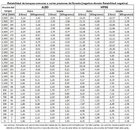This is a very odd, confused thread, IMO. In any case, if you're talking about equal amounts of air leaving two tanks, the change in weight will be exactly the same (ca. 8# per 100 cf as normally calculated.) That would be comparing an Al 100 to a steel 100, etc. Now the PERCENTAGE change in weight of the tank would be greater for the lighter (Alum) tank, but the "swing" due to the air in pounds would be identical.
Now, something that some folks fixate on is that an Alum 80 tank changes from negative to positive buoyancy when dropping from 3000 to 500 psi, but a steel tank stays negative (although less negative at 500psi). In other words, an empty Al 80 tank will float, but an empty steel tank will sink. But in terms of the buoyancy of the diver + rig + tank, the change in weight from using 2500 psi of air is the same, so if you're properly weighted (slightly negative with 500 psi), what's the big deal?
You need less lead with a (heavier steel) tank, but otherwise, why does the change from neg to pos buoyancy of the alum TANK make any difference at all? All I can think is the trim changes, since the empty Al tank becomes a "float" on your back, but the lead is on your belt / pockets. All the more reason to put some weight in cam band pockets, I guess...)
Anything wrong with my thinking?





